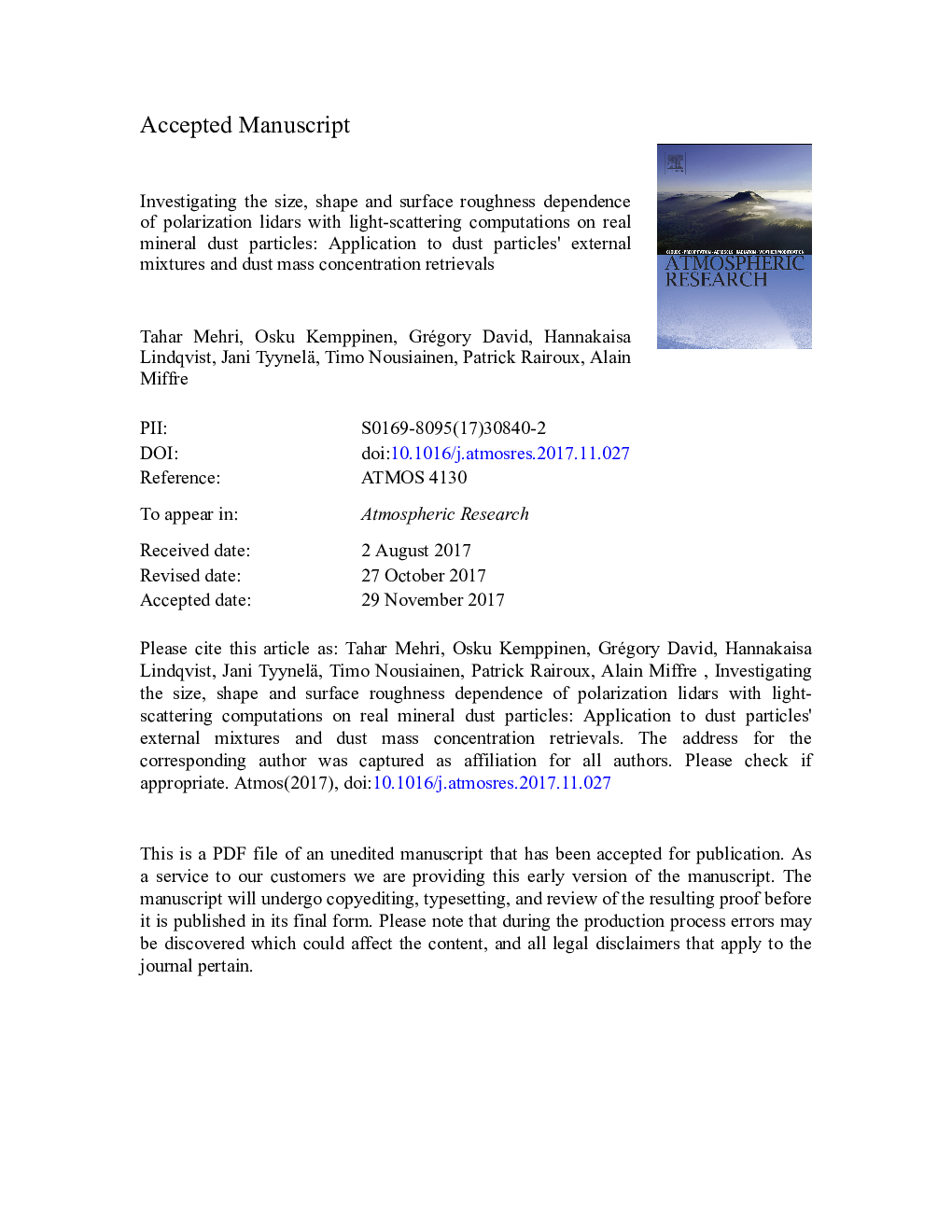| کد مقاله | کد نشریه | سال انتشار | مقاله انگلیسی | نسخه تمام متن |
|---|---|---|---|---|
| 8864745 | 1620478 | 2018 | 59 صفحه PDF | دانلود رایگان |
عنوان انگلیسی مقاله ISI
Investigating the size, shape and surface roughness dependence of polarization lidars with light-scattering computations on real mineral dust particles: Application to dust particles' external mixtures and dust mass concentration retrievals
ترجمه فارسی عنوان
بررسی اندازه، شکل و سطح زبری سطح لییدار قطبش با محاسبه پراکندگی نور بر ذرات گرد و غبار واقعی: کاربرد مخلوط خارجی ذرات گرد و غبار و بازیابی غلظت توده گرد و غبار
دانلود مقاله + سفارش ترجمه
دانلود مقاله ISI انگلیسی
رایگان برای ایرانیان
کلمات کلیدی
گرد و غبار معدنی، زبری سطح، غلظت توده، قطبش لیادار، شبیه سازی عددی نور پراکنده،
موضوعات مرتبط
مهندسی و علوم پایه
علوم زمین و سیارات
علم هواشناسی
چکیده انگلیسی
Our understanding of the contribution of mineral dust to the Earth's radiative budget is limited by the complexity of these particles, which present a wide range of sizes, are highly-irregularly shaped, and are present in the atmosphere in the form of particle mixtures. To address the spatial distribution of mineral dust and atmospheric dust mass concentrations, polarization lidars are nowadays frequently used, with partitioning algorithms allowing to discern the contribution of mineral dust in two or three-component particle external mixtures. In this paper, we investigate the dependence of the retrieved dust backscattering (βd) vertical profiles with the dust particle size and shape. For that, new light-scattering numerical simulations are performed on real atmospheric mineral dust particles, having determined mineralogy (CAL, DOL, AGG, SIL), derived from stereogrammetry (stereo-particles), with potential surface roughness, which are compared to the widely-used spheroidal mathematical shape model. For each dust shape model (smooth stereo-particles, rough stereo-particles, spheroids), the dust depolarization, backscattering Ã
ngström exponent, lidar ratio are computed for two size distributions representative of mineral dust after long-range transport. As an output, two Saharan dust outbreaks involving mineral dust in two, then three-component particle mixtures are studied with Lyon (France) UV-VIS polarization lidar. If the dust size matters most, under certain circumstances, βd can vary by approximately 67% when real dust stereo-particles are used instead of spheroids, corresponding to variations in the dust backscattering coefficient as large as 2 Mmâ 1·srâ 1. Moreover, the influence of surface roughness in polarization lidar retrievals is for the first time discussed. Finally, dust mass-extinction conversion factors (ηd) are evaluated for each assigned shape model and dust mass concentrations are retrieved from polarization lidar measurements. From spheroids to stereo-particles, ηd increases by about 30%. We believe these results may be useful for our understanding of the spatial distribution of mineral dust contained in an aerosol external mixture and to better quantify dust mass concentrations from polarization lidar experiments.
ناشر
Database: Elsevier - ScienceDirect (ساینس دایرکت)
Journal: Atmospheric Research - Volume 203, 1 May 2018, Pages 44-61
Journal: Atmospheric Research - Volume 203, 1 May 2018, Pages 44-61
نویسندگان
Tahar Mehri, Osku Kemppinen, Grégory David, Hannakaisa Lindqvist, Jani Tyynelä, Timo Nousiainen, Patrick Rairoux, Alain Miffre,
